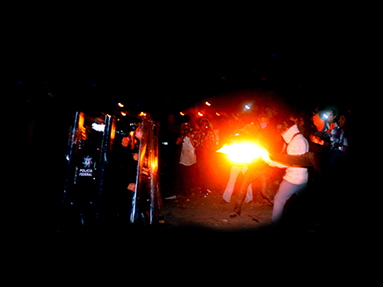The disappearance of 43 students in Ayotzinapa, and the revolutionary movement that has followed in its wake, marks the end of Mexico's sham "transition to democracy"
What happened in Iguala, Guerrero, on the night of September 26? According to the government's initial story, just an incident, horrible but isolated and the product of local causes: a handful of individuals acted badly and precipitated, by action or negligence, the death of six citizens and the forced disappearance of 43 student from a rural teachers college in Ayotzinapa. In another, less restrictive narrative—articulated by scholars and columnists and adopted within days by the government itself—it was a structural failure: a catastrophe serious enough to reveal all at once the dysfunction of the Mexican state and the need for thorough institutional reforms. But it is a different, and far more radical, narrative that has been been lighting up the streets and social networks for almost three months: what happened that night was an event, one of those watersheds that somehow escapes the chain of cause and effect and derails the course of history. Not a localized episode but a rupture that reveals a new horizon and divides time in two. Not a malfunction to be fixed, but an explosion that heralds the end of this order and the dawn of another.
These are the three stories competing to explain the crimes in Iguala. It is not an empty dispute: the legitimacy of political actors and their practices depends largely on the way those facts are translated into symbolizations. The government is already using the first two stories to their advantage. Those of us who see September 26 as the twilight of one epoch—and the protests that followed as the first rays of another—have a duty to promote the third narrative until it becomes hegemonic. As Alain Badiou has noted so often, one of our tasks is to remain faithful to the event, to the things we saw and felt during the pivotal days, once things seem to have gone back to “normal.” Another is to rigorously continue the intellectual work demanded by the event: rethinking our past and our future after Ayotzinapa. Because there is now a before and after Ayotzinapa.
In the light of Ayotzinapa, for example, Mexico's recent past looks completely different. In theory, for the last twenty or thirty years the country has navigated a fortuitous “transition to democracy.” Guided by a series of now-iconic personalities, we have been carried from a closed authoritarian regime, with a single hegemonic party, to another one that is plural, open, democratic at last. Long before Ayotzinapa, everyday life revealed the strains in this theory and the limits of this “transition,” which did represent a political aperture but never came close to forging a viable, transparent, and inclusive democracy. Ayotzinapa has revealed something even more radical: not that the transition was insufficient, but that it never started. Look closer: what took place was a reform—more or less thorough, more or less effective—of the existing regime and not the transition to another. This is clear now that the PRI is back in power, Televisa still dominates the media, and neoliberal policies are intensified. Rather than the dismantling of one regime and the constitution of another, there was a kind of pact between the political class, the oligarchy, and the various entrenched interests to guarantee the modified continuity of the same political class, oligarchy, and entrenched interests. It's not that the process was meaningless, just that it was much less profound than that its beneficiaries usually claim.
It follows that, contrary to some suggestions, the constellation of marches, actions, and protests that have followed the disappearance of the forty-three student-teachers is not a second wave of the transition. What we are living through is the transition—the possibility of a real transition. If the reformist campaign of the 1980s and 1990s in Mexico called for the democratization of institutions and mechanisms, the current multitude (a horizontal aggregation of singularities) has something bigger in its sights: the political class and the entrenched interests that have operated, currently operate, and intend to continue operating behind these mechanisms and institutions. In place of another negotiated reform, this multitude demands the suspension of the old agreements. In place of an accord which bargains certain changes for the persistence of the ruling class, they demand the recall of this class before anything else is decided. Not the reform of this regime but the constitution of another—this is the horizon that the event has disclosed.
Bureaucrats and columnists are already pressing the movement for clear demands and specific requests. Already certain academics, with the best of intentions, are proposing corrective measures and new government or citizen commissions that—whether they work or not—take for granted the endurance of the present regime. But for the multitude the state of emergency continues, and they remain, we might say, prediscursive and rightly refuse to fix a single negotiable agenda. Rather than translating itself into a discourse, the multitude spreads itself out again and again in a mass of desiring, irreducible, unassimilable bodies. This is the movement's political logic: no deliberation—not yet—but permanent mobilization, which aims not to solve the crisis of this regime but to sharpen it. And this is exactly what is happening: each time the multitude erupts in the streets, the regime is shown to be more decrepit and authoritarian, stripped of the legitimacy it needs to justify the use of law enforcement. Anyway, why would the multitude negotiate with a regime that, after what happened in Iguala, they already consider obsolete?
There are those who insist that the demand for the president's resignation is nothing but the whim of the most strident protestors, those who would have inflamed a “local incident” until it became a “coup.” The reality is the opposite: this demand—besides being democratic—is not a detour but the logical consequence of the political logic of the multitude, opposed, as we have seen, to the ruling class that has seized control of the state. Of course no one thinks the president's resignation would be a panacea. It would not even be sufficient. It is scarcely the basic condition of the movement's two principle objectives: unseating the political class and then calling them to account. Besides, whether or not Peña Nieto leaves office, a symbolic recall of authority has already occurred: for all who understand Ayotzinapa as an event—and there are millions of us—the president and his government are already the ancien régime. Even if for now they hang on and govern and repress, they are just the remnants of another time, already past, already obsolete.
Once the ancien régime is clearly a thing of the past, we will have to build a Mexico to come after Ayotzinapa—a Mexico in which, as a starting point, the conditions of possibility for another night like September 26 will not exist.

